History
 January 13, 1982 found Washington DC in the middle of a severe snowstorm. The Washington National Airport was closed due to heavy snowfall…in excess of 6.5 inches. The airport reopened at noon under barely marginal conditions, but decreasing snow. The planes that had been waiting, began the de-icing process, including an Air Florida Boeing 727. The plane had flown into Washington from Miami in the early afternoon and was supposed to return to Fort Lauderdale, Florida, after a short stop. The short layover turned into a much longer one when the airport closed. When it reopened, the plane was de-iced with chemical anti-freeze, but the planes still had difficulty moving away from the gate due to the ice, so when it eventually made it to the airport’s only usable runway, it was forced to wait 45 minutes more for clearance to take off.
January 13, 1982 found Washington DC in the middle of a severe snowstorm. The Washington National Airport was closed due to heavy snowfall…in excess of 6.5 inches. The airport reopened at noon under barely marginal conditions, but decreasing snow. The planes that had been waiting, began the de-icing process, including an Air Florida Boeing 727. The plane had flown into Washington from Miami in the early afternoon and was supposed to return to Fort Lauderdale, Florida, after a short stop. The short layover turned into a much longer one when the airport closed. When it reopened, the plane was de-iced with chemical anti-freeze, but the planes still had difficulty moving away from the gate due to the ice, so when it eventually made it to the airport’s only usable runway, it was forced to wait 45 minutes more for clearance to take off.
Not wanting to further delay the flight, the pilot, Larry Wheaton, did not return to the terminal for more de-icing, and worse, failed to turn on the plane’s own de-icing system. In fact, the pilot and co-pilot actually discussed the situation, and the co-pilot said “It’s a losing battle trying to de-ice these things. It gives you a false sense of security, that’s all it does.” During the delay, however, ice was accumulating on the wings, and 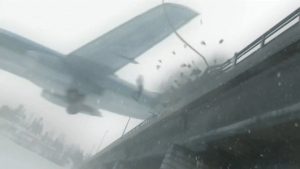 by the time the plane reached the end of the runway, it was able to achieve only a few hundred feet of altitude.
by the time the plane reached the end of the runway, it was able to achieve only a few hundred feet of altitude.
The Air Florida flight took off from Washington National Airport in Arlington, Virginia, with 74 passengers and 5 crew members on board. Thirty seconds later, the plane crashed into the 14th Street Bridge over the Potomac River, less than a mile away from the runway. Seven vehicles traveling on the bridge were struck by the 727 and the plane fell into the freezing water. It was later determined that 73 of the people on board the plane died from the impact, leaving only six survivors in the river. In addition, four motorists, who had been on the bridge, died in the crash. Terrible traffic in Washington that day made it almost impossible for rescue workers to reach the scene. Witnesses didn’t know what to do to assist the survivors who were stuck in the freezing river. Finally, a police helicopter arrived and began assisting the survivors in a very risky operation.
Two people in particular emerged as heroes during the rescue…Arland Williams and Lenny Skutnik. Known as 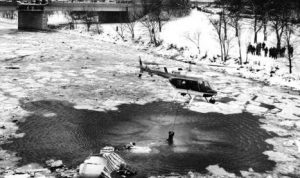 the “sixth passenger,” Williams survived the crash, and passed lifelines on to others rather than take one for himself. He ended up being the only plane passenger to die from drowning. When one of the survivors to whom Williams had passed a lifeline was unable to hold on to it, Skutnik, who was watching the unfolding tragedy, jumped into the water and swam to rescue her. Both Skutnik and Williams, along with bystander Roger Olian, received the Coast Guard Gold Lifesaving Medal. The bridge was later renamed the Arland D. Williams Jr. Memorial Bridge. It was a completely preventable tragedy, and all because they got in a hurry.
the “sixth passenger,” Williams survived the crash, and passed lifelines on to others rather than take one for himself. He ended up being the only plane passenger to die from drowning. When one of the survivors to whom Williams had passed a lifeline was unable to hold on to it, Skutnik, who was watching the unfolding tragedy, jumped into the water and swam to rescue her. Both Skutnik and Williams, along with bystander Roger Olian, received the Coast Guard Gold Lifesaving Medal. The bridge was later renamed the Arland D. Williams Jr. Memorial Bridge. It was a completely preventable tragedy, and all because they got in a hurry.
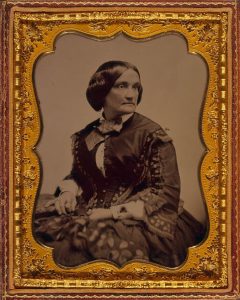 The Ambrotype (from the Ancient Greek words for immortal or impression) or Amphitype, also known as a collodion positive in England, is a positive photograph on glass made by a variant of the wet plate collodion process. Like a print on paper, it is viewed by reflected light. Like the Daguerreotype, which it replaced, and like the prints produced by a Polaroid camera, each is a unique original that could only be duplicated by using a camera to copy it.
The Ambrotype (from the Ancient Greek words for immortal or impression) or Amphitype, also known as a collodion positive in England, is a positive photograph on glass made by a variant of the wet plate collodion process. Like a print on paper, it is viewed by reflected light. Like the Daguerreotype, which it replaced, and like the prints produced by a Polaroid camera, each is a unique original that could only be duplicated by using a camera to copy it.
The Ambrotype was introduced in the 1850s. Then, during the 1860s it was replaced by the tintype, a similar photograph on thin black-lacquered iron, hard to distinguish from an Ambrotype, if under glass. It is quite the process. One side of a clean glass plate was coated with a thin layer of iodized collodion; which is a flammable, syrupy solution of pyroxylin (also known as “nitrocellulose,” “cellulose nitrate,” “flash paper,” and “gun cotton”) in ether and alcohol. The glass is then dipped in a silver nitrate solution. The plate was exposed in the camera while still wet. Exposure times varied from five to sixty seconds or more depending on the brightness of the lighting and the speed of the camera lens. The plate was then developed and fixed. The resulting negative, when viewed by reflected light against a black background, appears to be a positive image: the clear areas look black, and the exposed, opaque areas appear relatively light. This effect was integrated by backing the plate with black velvet; by taking the 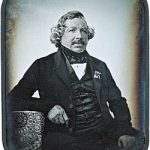 picture on a plate made of dark reddish-colored glass (the result was called a ruby Ambrotype); or by coating one side of the plate with black varnish. Either the emulsion side or the bare side could be coated: if the bare side was blackened, the thickness of the glass added a sense of depth to the image. In either case, another plate of glass was put over the fragile emulsion side to protect it, and the whole was mounted in a metal frame and kept in a protective case. In some instances the protective glass was cemented directly to the emulsion, generally with a balsam resin. This protected the image well but tended to darken it. Ambrotypes were sometimes hand-tinted; untinted ambrotypes are monochrome, gray or tan in their lightest areas.
picture on a plate made of dark reddish-colored glass (the result was called a ruby Ambrotype); or by coating one side of the plate with black varnish. Either the emulsion side or the bare side could be coated: if the bare side was blackened, the thickness of the glass added a sense of depth to the image. In either case, another plate of glass was put over the fragile emulsion side to protect it, and the whole was mounted in a metal frame and kept in a protective case. In some instances the protective glass was cemented directly to the emulsion, generally with a balsam resin. This protected the image well but tended to darken it. Ambrotypes were sometimes hand-tinted; untinted ambrotypes are monochrome, gray or tan in their lightest areas.
The Ambrotype was based on the wet plate collodion process invented by Frederick Scott Archer. Ambrotypes were deliberately underexposed negatives made by that process and optimized for viewing as positives instead. In the United States, ambrotypes first came into use in the early 1850s. In 1854, James Ambrose Cutting of 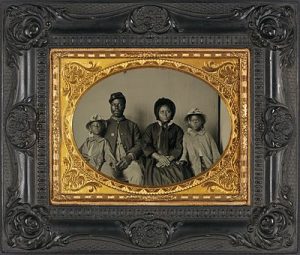 Boston took out several patents relating to the process. He may be responsible for coining the term “Ambrotype.” Ambrotypes were much less expensive to produce than daguerreotypes, the medium that predominated when they were introduced, and did not have the bright mirror-like metallic surface that could make daguerreotypes troublesome to view and which some people disliked. An Ambrotype, however, appeared dull and drab when compared with the brilliance of a well-made and properly viewed daguerreotype. It’s amazing to me that photography could be so complicated…especially when you think that these days, everything is digital, and errors can easily be fixed with Photoshop.
Boston took out several patents relating to the process. He may be responsible for coining the term “Ambrotype.” Ambrotypes were much less expensive to produce than daguerreotypes, the medium that predominated when they were introduced, and did not have the bright mirror-like metallic surface that could make daguerreotypes troublesome to view and which some people disliked. An Ambrotype, however, appeared dull and drab when compared with the brilliance of a well-made and properly viewed daguerreotype. It’s amazing to me that photography could be so complicated…especially when you think that these days, everything is digital, and errors can easily be fixed with Photoshop.
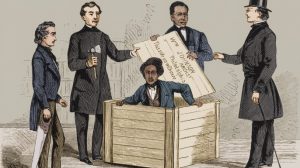 There are times when what you know is what gets you through a bad situation, but there are some situations that really do requiring knowing someone who can help. For the slaves in the pre-emancipation era of the United States, that was as true as it gets. The slaves had none of the most important asset needed for escape…money. That didn’t stop the attempts. One slave who was from the deeper south, Henry “Box” Brown, decided to mail himself to safety. That did work, but not everyone had the ability to get that done, and so the majority just decided to make a run for it…only to be met by dogs or Bounty Hunters…neither was going to have a good outcome.
There are times when what you know is what gets you through a bad situation, but there are some situations that really do requiring knowing someone who can help. For the slaves in the pre-emancipation era of the United States, that was as true as it gets. The slaves had none of the most important asset needed for escape…money. That didn’t stop the attempts. One slave who was from the deeper south, Henry “Box” Brown, decided to mail himself to safety. That did work, but not everyone had the ability to get that done, and so the majority just decided to make a run for it…only to be met by dogs or Bounty Hunters…neither was going to have a good outcome.
One rather famous slave named Mustapha, teamed up with a white hunchback named Arthur Howe and conned his way to freedom. It was probably the most outrageous, and yet the best planned escape there was. The plan was simple, the pair traveled through North Carolina and Virginia, telling anyone they met that Mustapha was Howe’s slave. Since Howe was famous for his fearsome appearance and “expressive of dark angry passions,” that few people dared to ask any more questions. Whenever Howe and Mustapha, reached a town, Howe would sell Mustapha for a tidy fee. After a few days recuperating, Mustapha would escape again and the partners would resume their journey. Not only did this help avoid bounty hunters, who would be looking for an escaped slave, rather than a current one, it brought in a tidy profit as well. Mustapha was quite a brave man. He was not worried that he would not be able to escape the people he was sold too. Most slaves struggled to escape once…Mustapha did it every week. 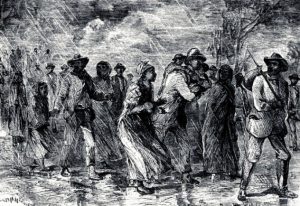 He also had to trust Howe to continue to be there waiting for him so they could continue their journey.
He also had to trust Howe to continue to be there waiting for him so they could continue their journey.
The plan worked perfectly and as planned the pair parted ways, after reaching Petersburg or Richmond. This put Mustapha free to make his escape north. Since he was not apprehended, it is believed that this was what happened. No one is exactly positive about that, but the duo dropped out of history after that, so it is believed to be the way everything went down. When we look back on the many deaths that followed an escape attempt, I have to think that it is sad that more slaves didn’t think of this idea. I’m sure the many slave owners who were scammed though, I think there was a little justice in the world after all.
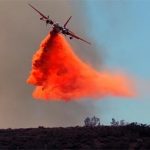 The Vietnam war was many things, but I don’t think anyone really expected Operation Ranch Hand…at least not the general public. Who would have expected such a heinous act to be carried out by the government. Operation Ranch Hand was a United States military operation during the Vietnam War, lasting from 1962 until 1971. The operation was largely inspired by the British use of 2,4,5-T and 2,4-D (Agent Orange) during the Malayan Emergency in the 1950s. It was part of the overall program during the war called “Operation Trail Dust.” Ranch Hand involved spraying an estimated 20 million United States gallons of defoliants and herbicides over rural areas of South Vietnam in an attempt to deprive the Viet Cong of food and vegetation cover. Nearly 20,000 sorties were flown between 1961 and 1971.
The Vietnam war was many things, but I don’t think anyone really expected Operation Ranch Hand…at least not the general public. Who would have expected such a heinous act to be carried out by the government. Operation Ranch Hand was a United States military operation during the Vietnam War, lasting from 1962 until 1971. The operation was largely inspired by the British use of 2,4,5-T and 2,4-D (Agent Orange) during the Malayan Emergency in the 1950s. It was part of the overall program during the war called “Operation Trail Dust.” Ranch Hand involved spraying an estimated 20 million United States gallons of defoliants and herbicides over rural areas of South Vietnam in an attempt to deprive the Viet Cong of food and vegetation cover. Nearly 20,000 sorties were flown between 1961 and 1971.
It’s hard to say if the government knew the consequences of the chemicals that were used. It’s possible that the chemicals were thought to just kill vegetation, and not to hurt people. The people involved were known as  Ranch Handers. I seriously doubt that at some point they didn’t wonder if what they were doing could possibly be harmful to the people they were spraying it on or near. Nevertheless, the “Ranch Handers” had a motto, “Only you can prevent a forest.” It was a take on the popular United States Forest Service poster slogan of Smokey Bear. During the ten years of spraying, over 5 million acres of forest and 500,000 acres of crops were heavily damaged or destroyed. Around 20% of the forests of South Vietnam were sprayed at least once.
Ranch Handers. I seriously doubt that at some point they didn’t wonder if what they were doing could possibly be harmful to the people they were spraying it on or near. Nevertheless, the “Ranch Handers” had a motto, “Only you can prevent a forest.” It was a take on the popular United States Forest Service poster slogan of Smokey Bear. During the ten years of spraying, over 5 million acres of forest and 500,000 acres of crops were heavily damaged or destroyed. Around 20% of the forests of South Vietnam were sprayed at least once.
The herbicides were sprayed by the United States Air Force flying C-123s using the call sign “Hades.” The planes were fitted with specially developed spray tanks with a capacity of 1,000 United States gallons of herbicides. A plane sprayed a swath of land that was ½ mile wide and 10 miles long in about 4½ minutes, at a rate of about 3 United States gallons per acre. Sorties usually consisted of three to five airplanes flying side by 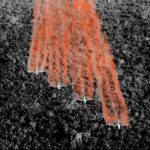 side, and 95% of the herbicides and defoliants used in the war were sprayed by the United States Air Force as part of Operation Ranch Hand. The remaining 5% were sprayed by the United States Chemical Corps, other military branches, and the Republic of Vietnam using hand sprayers, spray trucks, helicopters and boats, primarily around United States military installations…meaning that the majority of the chemicals were exposed to the Untied States Military. Many of the Vietnam veterans have felt betrayed by their own government. Many have felt that the government was well aware of the dangers of the chemicals they were spraying. I don’t know if they knew or not, but it seems like they should have suspected something. Years later, the effects of Agent Orange are well known and it was vicious.
side, and 95% of the herbicides and defoliants used in the war were sprayed by the United States Air Force as part of Operation Ranch Hand. The remaining 5% were sprayed by the United States Chemical Corps, other military branches, and the Republic of Vietnam using hand sprayers, spray trucks, helicopters and boats, primarily around United States military installations…meaning that the majority of the chemicals were exposed to the Untied States Military. Many of the Vietnam veterans have felt betrayed by their own government. Many have felt that the government was well aware of the dangers of the chemicals they were spraying. I don’t know if they knew or not, but it seems like they should have suspected something. Years later, the effects of Agent Orange are well known and it was vicious.
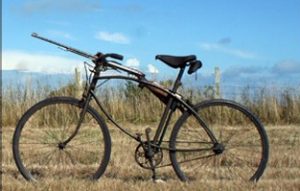
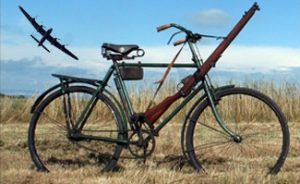 When we think about war machines, we think of planes, tanks, ships, and even horses, but we very seldom…if ever, think of bicycles. Nevertheless, bicycles were used in a number of wars, and even continue to be used to this day. The late 19th century brought several experiments into the possible role of bicycles and cycling within military establishments, primarily because they can carry more equipment and travel longer distances than walking soldiers could. The development of pneumatic tires coupled with shorter, sturdier frames in the late 19th century led military establishments to investigate the possibility of bicycles in combat. To some extent, bicyclists took over the functions of dragoons, especially as messengers and scouts, substituting for horses in warfare. Bicycle units or detachments were in existence by the end of the 19th century in most armies.
When we think about war machines, we think of planes, tanks, ships, and even horses, but we very seldom…if ever, think of bicycles. Nevertheless, bicycles were used in a number of wars, and even continue to be used to this day. The late 19th century brought several experiments into the possible role of bicycles and cycling within military establishments, primarily because they can carry more equipment and travel longer distances than walking soldiers could. The development of pneumatic tires coupled with shorter, sturdier frames in the late 19th century led military establishments to investigate the possibility of bicycles in combat. To some extent, bicyclists took over the functions of dragoons, especially as messengers and scouts, substituting for horses in warfare. Bicycle units or detachments were in existence by the end of the 19th century in most armies.
By World War I, the level terrain in Belgian was well used by military cyclists, prior to the onset of trench 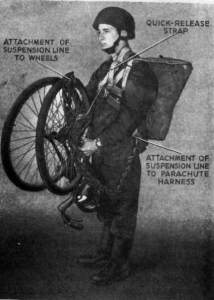 warfare. Each of the four Belgian carabinier battalions included a company of cyclists, equipped with a brand of folding, portable bicycle named the Belgica. A regimental cyclist school gave training in map reading, reconnaissance, reporting, and the carrying of verbal messages. Attention was paid to the maintenance and repair of the machine itself. The bicycle could be used to ride when it was feasible, and carried when the pat was not suitable to riding. The bicycle made no noise, so unless the trail was littered with twigs, the bicycle make very little noise. Sneaking up on the enemy was possible.
warfare. Each of the four Belgian carabinier battalions included a company of cyclists, equipped with a brand of folding, portable bicycle named the Belgica. A regimental cyclist school gave training in map reading, reconnaissance, reporting, and the carrying of verbal messages. Attention was paid to the maintenance and repair of the machine itself. The bicycle could be used to ride when it was feasible, and carried when the pat was not suitable to riding. The bicycle made no noise, so unless the trail was littered with twigs, the bicycle make very little noise. Sneaking up on the enemy was possible.
In the United States, the most extensive experimentation on bicycle units was carried out by 1st Lieutenant Moss, of the 25th United States Infantry (Colored), which was made up of African American infantry soldiers with European American officers. Using a variety of cycle models, Moss and his troops carried out extensive bicycle journeys covering between 800 and 1,900 miles. Late in the 19th century, the United States Army tested the bicycle’s suitability for cross-country troop transport. Buffalo Soldiers stationed in Montana rode bicycles across roadless landscapes for hundreds of miles at high speed. The “wheelmen” traveled the 1,900 Miles to Saint Louis, Missouri in 34 days with an average speed of over 6 miles per hour. The bicycles were even used in the paratrooper deployment. These bicycles not only folded up, but they were equipped with an on board rifle. I don’t know how hard it was to handle a gun while riding a bike, but I’m sure it was a relief to have your gun right there.
The first known use of the bicycle in combat occurred during the Jameson Raid, in which cyclists carried messages. In the Second Boer War, military cyclists were used primarily as scouts and messengers. One unit  patrolled railroad lines on specially constructed tandem bicycles that were fixed to the rails. Several raids were conducted by cycle-mounted infantry on both sides; the most famous unit was the Theron se Verkenningskorps (Theron Reconnaissance Corps) or TVK, a Boer unit led by the scout Daniel Theron, whom British commander Lord Roberts described as “the hardest thorn in the flesh of the British advance.” Roberts placed a reward of £1,000 on Theron’s head…dead or alive…and dispatched 4,000 soldiers to find and eliminate the TVK. While scouting alone on a road near Gatsrand, about 3.7 miles north of present-day Fochville, he encountered seven members of Marshall’s Horse and was killed in action.
patrolled railroad lines on specially constructed tandem bicycles that were fixed to the rails. Several raids were conducted by cycle-mounted infantry on both sides; the most famous unit was the Theron se Verkenningskorps (Theron Reconnaissance Corps) or TVK, a Boer unit led by the scout Daniel Theron, whom British commander Lord Roberts described as “the hardest thorn in the flesh of the British advance.” Roberts placed a reward of £1,000 on Theron’s head…dead or alive…and dispatched 4,000 soldiers to find and eliminate the TVK. While scouting alone on a road near Gatsrand, about 3.7 miles north of present-day Fochville, he encountered seven members of Marshall’s Horse and was killed in action.
 Sometimes, people can associate certain things with certain religions, and even Satanism. They can then make decisions on life based on what they perceive something to be. Unfortunately, sometimes those decisions end up being disastrous. Such was the case with Pope George IX, who decided that cats where a part of devil worship, and so ruled that cats should be exterminated. Cats throughout Europe were exterminated in droves immediately thereafter. Of course, we know that while some religions might use certain animals in their religious practices, that does not make the animal evil…but rather, the animal is a victim of that religion, much like people in certain religions use snakes as a part of worship.
Sometimes, people can associate certain things with certain religions, and even Satanism. They can then make decisions on life based on what they perceive something to be. Unfortunately, sometimes those decisions end up being disastrous. Such was the case with Pope George IX, who decided that cats where a part of devil worship, and so ruled that cats should be exterminated. Cats throughout Europe were exterminated in droves immediately thereafter. Of course, we know that while some religions might use certain animals in their religious practices, that does not make the animal evil…but rather, the animal is a victim of that religion, much like people in certain religions use snakes as a part of worship.
After the cats were removed from Europe, an unexpected and horrific side effect occurred. The sudden lack of cats led to the spread of disease because infected rats ran free. The most devastating of these diseases, the Bubonic Plague, killed 100 million people. Pope Gregory lived from 1145 to 1241, AD, so little was known about how disease was passed. He was born Ugolino di Conti but took the name Gregory when he became the pope. That was when Ugolino was over 80 years old, not a young age to take on the papal role.
The cat fiasco is just one part of Pope Gregory IX’s story. He is mostly known for issuing the Decretals and starting the Papal Inquisition. The Decretals reorganized the whole library of Catholic laws. The papal inquisition rained down justice on heretics, the people who spoke out against the church. It was Gregory’s past  as a lawyer that connected him to his acts of justice within the church. It was his distaste for cats that penned the Vox in Rama (the papal decree – this one about the cats). That was the first church document condemning black cats as instruments of satan. By Gregory’s decree, there was a target on the head of every black cat. The Black Death or Black Plague was the original zombie apocalypse. People living during this time lived in constant fear of death. Many believed this was the end of the human race, and that is understandable. It was one of the most deadly pandemics in history. By rough estimates, as many as 200 million people died. If you survived, you lost many loved ones, and in Europe, it was all because of a lack of cats.
as a lawyer that connected him to his acts of justice within the church. It was his distaste for cats that penned the Vox in Rama (the papal decree – this one about the cats). That was the first church document condemning black cats as instruments of satan. By Gregory’s decree, there was a target on the head of every black cat. The Black Death or Black Plague was the original zombie apocalypse. People living during this time lived in constant fear of death. Many believed this was the end of the human race, and that is understandable. It was one of the most deadly pandemics in history. By rough estimates, as many as 200 million people died. If you survived, you lost many loved ones, and in Europe, it was all because of a lack of cats.
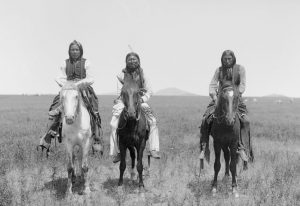 The battle for lands owned, desired, or presumed owned, is one that has raged in the United States for many, many years. When the pilgrims first came to the new world, it did not seem like a problem to the Native Americans, but as more and more “White Men” came, the Native Americans could see the writing on the wall. so to speak. They knew that their wide open spaces were in jeopardy, and they were determined not to lose the battle for their most prized possession…land. In the 18th and 19th centuries settlers from Europe moved westward across America in a steady wave. The migration overwhelmed ancient tribes like the Iroquois, the Cherokee, and the Shawnee. But when the settlers reached Texas and the lands of the Comanche, the migration stopped in it’s tracks. Many of the Indians back then were somewhat like the settlers. They had their villages, and they stayed in one place, or moved slowly from one place to another. The Comanche were just like that, until the horse arrived in North America. But the Comanche adapted to the horse like no other Native American group. They became nomads, following the buffalo, and as they exploded across the Texas plains, they virtually wiped out the Apache. Their enormous horse herds were legendary, as were their riding skills. While the Cheyenne and Sioux would dismount before battles, the Comanche mastered the art of fighting on horseback. They planted no crops, built no settlements, and shunned complex ritual or religion. The name “Comanche” was given to them by the Utes. It means “enemies.”
The battle for lands owned, desired, or presumed owned, is one that has raged in the United States for many, many years. When the pilgrims first came to the new world, it did not seem like a problem to the Native Americans, but as more and more “White Men” came, the Native Americans could see the writing on the wall. so to speak. They knew that their wide open spaces were in jeopardy, and they were determined not to lose the battle for their most prized possession…land. In the 18th and 19th centuries settlers from Europe moved westward across America in a steady wave. The migration overwhelmed ancient tribes like the Iroquois, the Cherokee, and the Shawnee. But when the settlers reached Texas and the lands of the Comanche, the migration stopped in it’s tracks. Many of the Indians back then were somewhat like the settlers. They had their villages, and they stayed in one place, or moved slowly from one place to another. The Comanche were just like that, until the horse arrived in North America. But the Comanche adapted to the horse like no other Native American group. They became nomads, following the buffalo, and as they exploded across the Texas plains, they virtually wiped out the Apache. Their enormous horse herds were legendary, as were their riding skills. While the Cheyenne and Sioux would dismount before battles, the Comanche mastered the art of fighting on horseback. They planted no crops, built no settlements, and shunned complex ritual or religion. The name “Comanche” was given to them by the Utes. It means “enemies.” 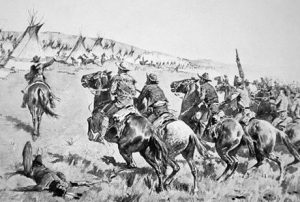
Unfortunately for the Comanche, they were no match for the settlers. After being beaten early on, the Comanche avoided direct conflict for the most part. They preferred to attack undefended farmhouses, slaughtering the inhabitants. It worked, the settlers were too afraid to travel into Comanche territory, and European expansion almost came to a screeching halt. In 1858, after a particularly bloody year, the Texas Rangers were ordered to take care of the Comanche. The empire of the Texas plains was a brutal and unchanging grassland of deadly heat and vast wildfires. No European had traveled very far into the territory, but now the Rangers intended to do just that. They were accompanied by a group of Tonkawas, a local tribe hated by other Native Americans for their cannibalism. The Comanche slaughtered the Tonkawas whenever possible, and the survivors were out for revenge. Together, the Rangers and the Tonkawas traveled for weeks, even fording stretches of pure quicksand, until they discovered a huge Comanche camp stretching along a creek in the Antelope Hills. The Comanche sprang onto their horses, but it was too late. They never expected to be attacked in the heart of the Comancheria and were in no position to fight. It looked as if all was lost, and indeed it was, but they did not know that yet.

Suddenly, Chief Iron Jacket rode out of the chaos. His true name was Pobishequasso, but he was known as Iron Jacket for his ancient coat of Spanish armor, a family heirloom looted from the corpse of some unlucky conquistador. He exhaled great breaths of air as he rode toward the Rangers, working his medicine, which was said to blow bullets off target. The Rangers and the Tonkawas opened fire, but Iron Jacket kept coming. The bullets seemed to bounce off him, and for a moment, it seemed that he was unstoppable. Then, the magic ended. A hail of rifle fire cut down his horse, and a second volley finished Pobishequasso. His followers…armed only with lances and ancient muskets..fled, pursued by the Rangers, who picked off at least 76 of them. In the years that followed, the settlers became bolder, launching numerous raids into the Comancheria. Iron Jacket’s rusting armor was broken up for souvenirs. The reign of the Comanche was over.
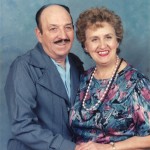
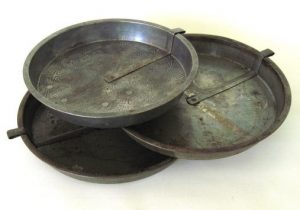 Every New Year’s Eve for as long as I can remember, our family threw a party, both for the New Year and for my mom’s birthday, which is January 1. It is our New Year’s Eve Tradition. As I was thinking about our tradition, I wondered about other New Year’s Eve Traditions. So, I decided to research some of them. Wow!! There are some really strange traditions out there. One I found particularly strange was that in Switzerland, they drop a dollop of ice cream on the floor. It is supposed to bring overflowing abundance in the New Year. Now, I don’t know about you, but I think that is strange…and messy. In Spain, it is all about good timing. When the clock strikes midnight, Spaniards try to eat a grape in time with each chime. Those who don’t manage to cram the right number of grapes at the right time face the threat of bad luck for the following year. Be warned, it’s not as easy as it sounds, apparently. Many people practice beforehand to increase their chances of beating the clock. This is serious business from what I read. In Czechoslovakia, they like to look to their future around New Year’s, usually with the help of an apple. The fruit is cut in half and the shape of the core determines the person’s fate. If it’s a cross, mischief is on the way, but if it’s a star, you can expect happiness. Apparently, many New Year’s Eve traditions center around food…including our party, but our party doesn’t have any traditions that involve the food.
Every New Year’s Eve for as long as I can remember, our family threw a party, both for the New Year and for my mom’s birthday, which is January 1. It is our New Year’s Eve Tradition. As I was thinking about our tradition, I wondered about other New Year’s Eve Traditions. So, I decided to research some of them. Wow!! There are some really strange traditions out there. One I found particularly strange was that in Switzerland, they drop a dollop of ice cream on the floor. It is supposed to bring overflowing abundance in the New Year. Now, I don’t know about you, but I think that is strange…and messy. In Spain, it is all about good timing. When the clock strikes midnight, Spaniards try to eat a grape in time with each chime. Those who don’t manage to cram the right number of grapes at the right time face the threat of bad luck for the following year. Be warned, it’s not as easy as it sounds, apparently. Many people practice beforehand to increase their chances of beating the clock. This is serious business from what I read. In Czechoslovakia, they like to look to their future around New Year’s, usually with the help of an apple. The fruit is cut in half and the shape of the core determines the person’s fate. If it’s a cross, mischief is on the way, but if it’s a star, you can expect happiness. Apparently, many New Year’s Eve traditions center around food…including our party, but our party doesn’t have any traditions that involve the food.
Several of the traditions sounded very familiar to me, because they are traditions I have grown up with. Many places celebrate with fireworks on New Year’s Eve. In some places, it is believed that the noise and light from fireworks and sparklers would scare away bad spirits, not something I believe in, but some people might. At our house, midnight means that it’s time to “beat the pans.” It’s something we have done since I was a little girl, and a tradition that my sisters and I would not change. It reminds us of our parents, and makes it seem like they are there with us on that special night each year. I do think that my parents might be surprised to find out that their tradition, that they made up, is one that is also tradition in Iran…I was very surprised.
A couple of traditions were, strange to me. People in Buenos Aires, Argentina, have an unusual tradition. On the last day of the year they shred old documents and papers to symbolize leaving the past behind. Around noon, on New Year’s Day, people throw the scraps of paper from their windows all over the city in a shower of confetti. Out with the old and in with the new, I guess. I hope they never need those documents. As strange as that tradition was, the winner of the strangest tradition on Earth…in my mind at least it the one celebrated in Peru. The last day of December…New Year’s Eve, is the day of the Takanakuy Festival. The Takanakuy Festival is the craziest festival I have ever heard of. The Takanakuy Festival, is the fighting festival. Every year people 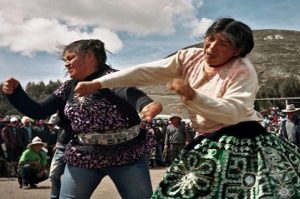
 of Peru have a fist fight to settle their differences. Can you imagine a whole town fighting in the street? They then start the year off on a clean slate on New Year’s Day. I guess then that it must be illegal (or at least, in very bad taste) to be mad about anything or at anyone that you had a fist fight with the day before. Now, I think that the tradition of not carrying any arguments into the new year is a really good one, but I know that I would not want to have to go through that whole fist fight part of the festival. Nope…I sure wouldn’t.
of Peru have a fist fight to settle their differences. Can you imagine a whole town fighting in the street? They then start the year off on a clean slate on New Year’s Day. I guess then that it must be illegal (or at least, in very bad taste) to be mad about anything or at anyone that you had a fist fight with the day before. Now, I think that the tradition of not carrying any arguments into the new year is a really good one, but I know that I would not want to have to go through that whole fist fight part of the festival. Nope…I sure wouldn’t.
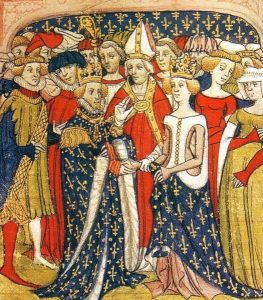 Most people think that English came from England, and of course, it did, however, in England prior to the 19th century, the English language was not spoken by the aristocracy, but rather only by “commoners.” Back then, English used to belong to the people, and I suppose that might explain some of the “incorrect” uses of the language which have been so severely attacked by contemporary English speakers. Prior to the 19th century, the aristocracy in English courts spoke French. This was due to the Norman Invasion of 1066 and caused years of division between the “gentlemen” who had adopted the Anglo-Norman French and those who only spoke English. Even the famed King Richard the Lionheart was actually primarily referred to in French, as Richard “Coeur de Lion.”
Most people think that English came from England, and of course, it did, however, in England prior to the 19th century, the English language was not spoken by the aristocracy, but rather only by “commoners.” Back then, English used to belong to the people, and I suppose that might explain some of the “incorrect” uses of the language which have been so severely attacked by contemporary English speakers. Prior to the 19th century, the aristocracy in English courts spoke French. This was due to the Norman Invasion of 1066 and caused years of division between the “gentlemen” who had adopted the Anglo-Norman French and those who only spoke English. Even the famed King Richard the Lionheart was actually primarily referred to in French, as Richard “Coeur de Lion.”
In my opinion, this dual language society would have caused numerous problems. The indication I get is that neither side could speak the language of the other, but I don’t know how a monarchy could rule, if the “commoners” could not understand the language and therefore the orders of the monarchy. French was spoken and learned by anyone in the upper 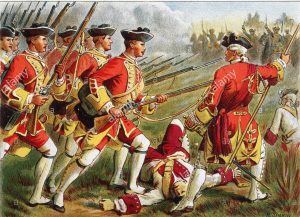 classes. However, it became less useful as English lost its control of various places in France, where the peasants spoke French, too. After that…about, 1450…English was simply more useful for talking to anybody. It is still true that British royals and many nobles are fluent in French, but they only use it to talk to French people, just like everybody else.
classes. However, it became less useful as English lost its control of various places in France, where the peasants spoke French, too. After that…about, 1450…English was simply more useful for talking to anybody. It is still true that British royals and many nobles are fluent in French, but they only use it to talk to French people, just like everybody else.
To further confuse your preconceptions about the English language, the “British accent” was, in reality, created after the Revolutionary War, meaning contemporary Americans sound more like the colonists and British soldiers of the 18th century than contemporary Brits. Many people have made a point of how much they love the British accent, but I think very few people know the real story behind the British accent. In the 18th century and before, the British “accent” was the way we speak herein America. Of course, accents vary greatly  by region, as we have seen with the accents of the south and east in the United States, but the “BBC English” or public school English accent…which sounds like the James Bond movies…didn’t come about until the 19th century and was originally adopted by people who wanted to sound fancier. I suppose it was like the aristocracy and the commoners, in that one group didn’t want to be mistaken for the other. After being handily defeated by the American colonists, I’m sure that the British were looking for a way to seem superior, even in defeat. The change in the accent of the English language was sufficient to make that distinction. Maybe it was their way of saying that they were better than the American guerilla-type soldiers who beat them in combat…basically they might have lost, but they were superior…even if it was only in how they sounded.
by region, as we have seen with the accents of the south and east in the United States, but the “BBC English” or public school English accent…which sounds like the James Bond movies…didn’t come about until the 19th century and was originally adopted by people who wanted to sound fancier. I suppose it was like the aristocracy and the commoners, in that one group didn’t want to be mistaken for the other. After being handily defeated by the American colonists, I’m sure that the British were looking for a way to seem superior, even in defeat. The change in the accent of the English language was sufficient to make that distinction. Maybe it was their way of saying that they were better than the American guerilla-type soldiers who beat them in combat…basically they might have lost, but they were superior…even if it was only in how they sounded.
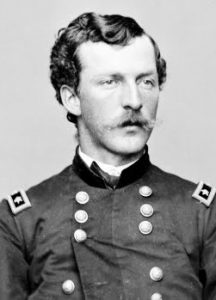
 Who shot first? We will never know, but on December 29, 1890, that first shot started a massacre. What lead up to that fateful day? For all of his 27 years, Black Elk’s had watched as the way of life of the Lakota Sioux on the Great Plains was taken away. Black Elk was a medicine man, who witnessed years of broken treaties. He watched as the white men “came in like a river” when gold was discovered in the Dakota Territory’s Black Hills in 1874. He was there two years later when Custer and his men were annihilated at Little Big Horn. He saw the Lakota’s traditional hunting grounds evaporate as white men decimated the native buffalo population. The Lakota, who once roamed as free as the bison on the Great Plains, were now mostly confined to government reservations.
Who shot first? We will never know, but on December 29, 1890, that first shot started a massacre. What lead up to that fateful day? For all of his 27 years, Black Elk’s had watched as the way of life of the Lakota Sioux on the Great Plains was taken away. Black Elk was a medicine man, who witnessed years of broken treaties. He watched as the white men “came in like a river” when gold was discovered in the Dakota Territory’s Black Hills in 1874. He was there two years later when Custer and his men were annihilated at Little Big Horn. He saw the Lakota’s traditional hunting grounds evaporate as white men decimated the native buffalo population. The Lakota, who once roamed as free as the bison on the Great Plains, were now mostly confined to government reservations.
Life for the Sioux was very bleak during the winter of 1890. Then came a glimmer of hope with the new Ghost Dance spiritual movement, which preached that Native Americans had been confined to reservations because they had angered the gods by abandoning their traditional customs. Leaders promised that the buffalo would return, relatives would be resurrected and the white man would be cast away if the Native Americans performed a ritual “ghost dance.” Such a ritual was seriously scary for the “white man.” The settlers grew increasingly alarmed and worried that an uprising was coming. “Indians are dancing in the snow and are wild and crazy,” telegrammed a frightened government agent stationed on South Dakota’s Pine Ridge Reservation to the commissioner of Indian affairs on November 15, 1890. “We need protection and we need it now.”
General Nelson Miles arrived with 5,000 troops as part of the Seventh Cavalry, which was Custer’s old command. He ordered the arrest of several Sioux leaders. When Indian police tried to arrest Chief Sitting Bull, who was mistakenly believed to have been joining the Ghost Dancers, the noted Sioux leader was killed in the melee. Then, on December 28, the cavalry caught up with Chief Big Foot, who was leading a band of upwards of 350 people to join Chief Red Cloud, near the banks of Wounded Knee Creek. The American forces arrested Big Foot, who was too ill with pneumonia to sit up, let alone walk, and positioned their Hotchkiss guns on a rise overlooking the Lakota camp. As a bugle blared the following morning, December 29, American soldiers mounted their horses and surrounded the Native American camp. A medicine man who started to perform the ghost dance cried out, “Do not fear but let your hearts be strong. Many soldiers are about us and have many bullets, but I am assured their bullets cannot penetrate us.” He implored the heavens to scatter the soldiers like the dust he threw into the air.
The cavalry went teepee to teepee seizing axes, rifles and other weapons. As the soldiers attempted to confiscate a weapon they spotted under the blanket of a deaf man, who could not hear their orders, a gunshot suddenly rang out. It was not clear which side shot first, but within seconds the American soldiers launched a hail of bullets from rifles, revolvers and rapid-fire Hotchkiss guns into the teepees. Outnumbered and 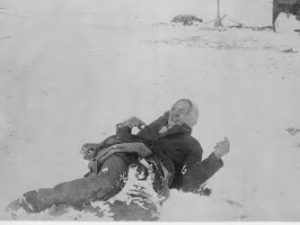
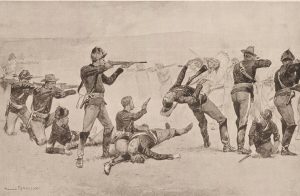 outgunned, the Lakota offered meek resistance. Big Foot was shot where he lay on the ground. Boys who had been happily playing leapfrog were mowed down. In just a matter of minutes, at least 150 Lakota Sioux Indians were killed along with 25 American soldiers. Half the victims were women and children. The soldiers might have thought they were being attacked…it’s hard to say. Nevertheless, that first shot brought about a massacre.
outgunned, the Lakota offered meek resistance. Big Foot was shot where he lay on the ground. Boys who had been happily playing leapfrog were mowed down. In just a matter of minutes, at least 150 Lakota Sioux Indians were killed along with 25 American soldiers. Half the victims were women and children. The soldiers might have thought they were being attacked…it’s hard to say. Nevertheless, that first shot brought about a massacre.

